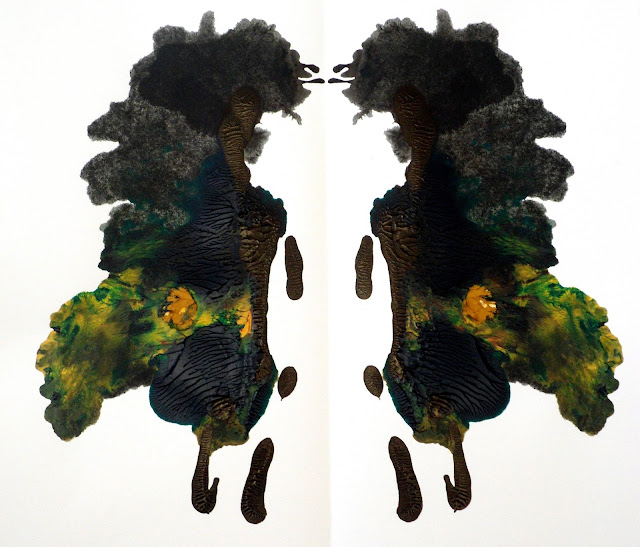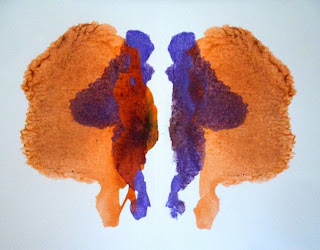My interest in symmetry stems from my fascination with human
beings and the relationship between psychology, science, and spirituality. My work explores in particular how we seem to be innately, and unconsciously aware of the fundamental laws which exist in
maths, science and therefore, nature.
In biology,
symmetry is prevalent a lot of the time. Most animals, and natural forms, have
elements of bilateral symmetry, most commonly known for it would be a
butterfly, or even our own bodies. It’s not surprising then that a random
symmetrical image may remind us of this.
However a symmetrical building, or even a symmetrical image of something
with geometrical shapes, wouldn’t trigger this same effect in us. It seems to
be the random, almost messy application of marks which, once printed, create
this response. This “messy” application
creates an image more complex than that which has simple geometric shapes. And
natural, biological forms are complex in structure, but still retain a sort of
order, which, clearly must be symmetry. Perhaps randomness, teamed with a
certain fundamental order is what is responsible for complex beings? We as
human beings are drawn towards anything that may look like a living being. This
understandably is an important survival technique. We are also attracted to
symmetry because it represents health and stability.
I like to play around with the idea of chance, and random mark making within my work. I started, and eventually finished my project with looking at blot prints. The process of applying paint, or ink, or indeed any material that can be printed on paper, is quite purposeful. The process of folding the paper and printing it to the other side is also purposeful. Once you open the paper the process of folding the paper has created a mirror image on the other side of the paper and you are left with a symmetrical image. However, as the printing process alters the materials on the paper you are never sure what image you will end up with once it’s finished. With any other painting you paint an image, and its completely purposeful. You know what image it is you want to create and you apply the paint as to how you want it. The outcomes of these prints do not always turn out how you would expect, even if you control the way you apply the paint in the first place. Interestingly, the images seem to all have a similar quality. They seem to give you a feeling of familiarity when you look at them, and that familiarity is something of a natural being, in mostly all images created.
I like to play around with the idea of chance, and random mark making within my work. I started, and eventually finished my project with looking at blot prints. The process of applying paint, or ink, or indeed any material that can be printed on paper, is quite purposeful. The process of folding the paper and printing it to the other side is also purposeful. Once you open the paper the process of folding the paper has created a mirror image on the other side of the paper and you are left with a symmetrical image. However, as the printing process alters the materials on the paper you are never sure what image you will end up with once it’s finished. With any other painting you paint an image, and its completely purposeful. You know what image it is you want to create and you apply the paint as to how you want it. The outcomes of these prints do not always turn out how you would expect, even if you control the way you apply the paint in the first place. Interestingly, the images seem to all have a similar quality. They seem to give you a feeling of familiarity when you look at them, and that familiarity is something of a natural being, in mostly all images created.
To finalise my project I decided to take the
prints a step further by creating a stop frame animation. Turning these prints into a moving image, not
only gives the images a further dimension but it also shows the process of how
natural forms are built up slowly over time, and become increasingly more
complex. It also demonstrates the idea that nature is ever changing, and ever
growing, but the animation plays on loop which validates there is still some
consistency within it.
Overall the aim
for this project is to look at how we consciously and unconsciously perceive
and makes sense of the objectivity of the fundamental laws within nature, and
also to remind and perhaps reveal the important part that symmetry has to play
in the constant cycle of nature and the universe, and the effect this has on
our minds and our lives as evolutionary beings.





















